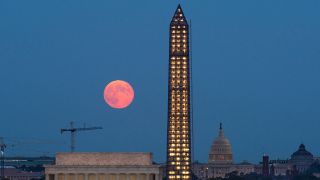The full Harvest Moon of 2021 rises tonight: Here's what to look for

The Harvest Moon rises tonight, accompanied by brightly shining planets Venus and Jupiter. The last full moon before this year's autumnal equinox, the Harvest Moon will be visible during night hours, weather permits, until the early hours of Wednesday.
On the U.S. East Coast, the Harvest Moon will emerge just above the eastern horizon at 7:13 p.m. EDT on the evening of Monday (Sept. 20). It will properly reach its full phase about 40 minutes later, at 7:55 p.m. EDT.
The moon will appear full on Monday for observers located westward from the western coast of Africa all the way to the International Date Line (a boundary stretching from the North Pole to the South Pole across the Pacific Ocean where each calendar day starts). Observers based in Europe, Asia, Australia and most of Africa will see the full moon on Tuesday (Sept. 21).
Related: How to photograph the moon using a camera: techniques, kit, and settings
Orion GoScope II 70 Telescope Moon Kit: <a href="https://target.georiot.com/Proxy.ashx?tsid=72128&GR_URL=https%3A%2F%2Famazon.com%2FOrion-10034-Refractor-Telescope-Burgundy%2Fdp%2FB00GTXIY28%3Ftag%3Dhawk-future-20%26ascsubtag%3Dhawk-custom-tracking-20" data-link-merchant="Amazon US"">$89.99 at Amazon
If you know a youngster who can't get enough of the moon, then they'll be delighted with views through the Orion GoScope II. Revealing craters and seas up close, this little telescope comes with a carry case and moon map.
The Harvest Moon, which got its name as it coincides with the harvest season in Europe and North America, will rise in the constellation of Pisces, according to NASA, just two days after passing Jupiter and four days before making a close approach to Uranus.
More: Night sky, September 2021: What you can see this month [maps]
Venus, the brightest planet visible as the moon appears, will be located 7 degrees above the horizon in the west-southwest. The next brightest planet, Jupiter, will appear 24 degrees above the horizon in the southeast. The faintest of the visible planets in the sky will be Saturn, appearing 27 degrees above the horizon in the south-southeast. Keen skywatchers may be able to briefly spot Mercury about 30 minutes after sunset before it disappears below the west-southwest horizon.
Get the Space.com Newsletter
Breaking space news, the latest updates on rocket launches, skywatching events and more!
The Harvest Moon also marks a rapid shortening of the day in the Northern Hemisphere. While on Tuesday (Sept. 22), the day of the autumnal equinox, morning twilight begins at 5:58 a.m. and the sun rises at 6:56 a.m., by the time of the next full moon on Oct. 20, morning twilight will begin at 6:25 a.m. and the sun will rise at 7:23 a.m.
Follow Tereza Pultarova on Twitter @TerezaPultarova. Follow us on Twitter @Spacedotcom and on Facebook.
Join our Space Forums to keep talking space on the latest missions, night sky and more! And if you have a news tip, correction or comment, let us know at: community@space.com.

Tereza is a London-based science and technology journalist, aspiring fiction writer and amateur gymnast. Originally from Prague, the Czech Republic, she spent the first seven years of her career working as a reporter, script-writer and presenter for various TV programmes of the Czech Public Service Television. She later took a career break to pursue further education and added a Master's in Science from the International Space University, France, to her Bachelor's in Journalism and Master's in Cultural Anthropology from Prague's Charles University. She worked as a reporter at the Engineering and Technology magazine, freelanced for a range of publications including Live Science, Space.com, Professional Engineering, Via Satellite and Space News and served as a maternity cover science editor at the European Space Agency.

